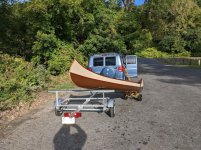Do you like or dislike or feel neutral about keels on wood/canvas canoes? Why? Does it depend on circumstances? What?
I haven't particularly liked them on the three canoes I've had. My paddling skills are more than sufficient to keep any keelless canoe going straight, and a keel limits maneuverability unless you heel the canoe off the keel. There are two things I'll say in a keel's favor. It helps a little to keep a canoe from windcocking and leecocking in winds, and it helps to protect the bottom of the canoe from some bottom bumps and scratches.
I haven't particularly liked them on the three canoes I've had. My paddling skills are more than sufficient to keep any keelless canoe going straight, and a keel limits maneuverability unless you heel the canoe off the keel. There are two things I'll say in a keel's favor. It helps a little to keep a canoe from windcocking and leecocking in winds, and it helps to protect the bottom of the canoe from some bottom bumps and scratches.

